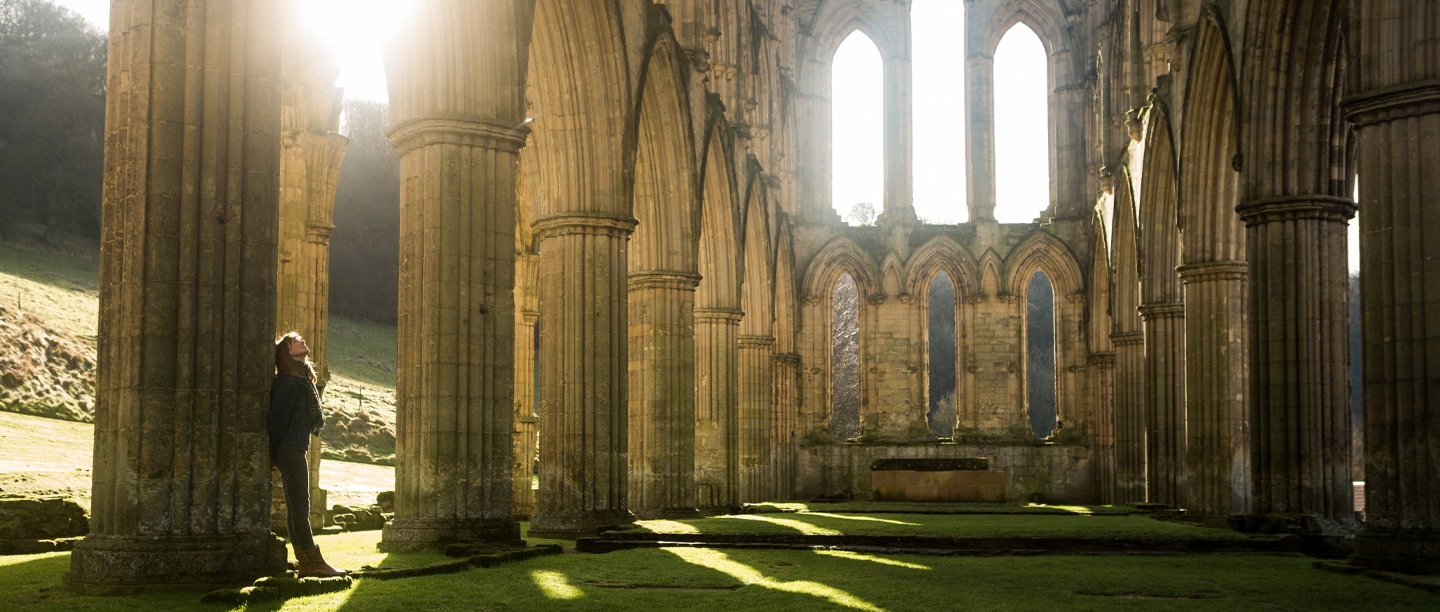1. Make history this half-term
This half-term get active outdoors and enjoy fun-filled family activities at your favourite castles, abbeys and historic houses.
At several sites there will be the opportunity to join characters from the past for historical high jinks and hands-on shenanigans. Be transported back in time to medieval England at Warkworth Castle and learn how to be a knight in our sword school. Delve into Wrest Park’s past and become an archaeologist for the day with our Time Capsule performers and kid’s dig. Or have a go at Tudor courtly etiquette at Eltham Palace.
We also have a list of 20 things to do before you turn 13 to inspire young adventurers. The items can be ticked off at home, at your local English Heritage site or while you are on holiday around England.
Find out more2. Walk through scenic landscapes
Despite the chill in the air, February is the perfect time to go on an adventure through picturesque surroundings.
Many of our sites are linked by scenic walks. For example, Rievaulx Abbey and Helmsley Castle are joined by a 2.5 mile route that takes in beautiful North Yorkshire countryside and the charming town of Helmsley. Follow one of our walking guides to spend the whole day out in a spectacular historical landscape.
Alternatively, take a look at our list of historic gardens highlights. The unique features that make them special might help to determine your next visit.
Find out more3. Find your new favourite site
The upcoming half term is ideal for exploring new places and experiencing history-filled days out. We’ve pulled together a list of recommendations for top sites to visit this half term. There’s something for every member of the family to enjoy, including options for dog-friendly days out. Warm up in one of our tearooms and watch your little adventurers burn off their excess energy in our play areas.
If you’re looking for family experiences that won’t break the bank, we also have suggestions for family days out on a budget.
Find out more4. Get inspired by history this Valentine’s Day
Gifting flowers is a Valentine’s Day staple. During the 19th century the Victorians developed their own floral language. There is even evidence that Queen Victoria and Albert used flowers to prove their love for each other. Treat your significant other to a thoughtful floral gift this Valentine’s Day by learning about the Victorians' meanings for different flowers. Make sure to avoid lavender meaning distrust or yellow roses meaning infidelity!
For other unique Valentine’s Day gift ideas, our online shop has a range of history-inspired gifts. With everything from jewellery and hand cream to replica swords and gin.
Find out more5. Discover the stories behind the blue plaques
London is now home to over 1000 blue plaques. There are many extraordinary stories to be discovered about the people behind the plaques. February is LGBTQ+ history month, and you can find out more about the lives and achievements of several of London’s LGBTQ+ former residents.
The blue plaque decorating Oscar Wilde’s former home marks the place where he wrote his classic first novel, The Picture of Dorian Gray (1891). In Maida Vale you can find a blue plaque commemorating the place where Alan Turing was born. He is known for his vital contribution to the deciphering of the German Enigma code during World War 2. One of history’s greatest rock stars also has a blue plaque; there is one on Freddy Mercury's family home where he explored his musical talents as a teenager.
Find out moreThe Month In History
- The great English landscape gardener, Lancelot ‘Capability’ Brown, passed away on 6 February 1783. Brown is remembered for designing over 250 idyllic landscapes, including parts of the grounds at Wrest Park in Bedfordshire and Audley End House in Essex.
- Charles Dickens was born on 7 February 1812 in Portsmouth. He wrote many of his early works, including Oliver Twist, at his home on Doughty Street in Bloomsbury.
- The bacteriologist Sir Alexander Fleming first published his discovery of penicillin on 14 February 1929. His home in Chelsea is now marked by a blue plaque.
- Charles Darwin, author of On the Origin of Species, was born on 12 February 1809. Darwin spent 40 years living in Down House where he wrote his theory of Evolution by Natural Selection. Visitors can follow in the great scientist’s footsteps, as well as explore the rooms and award-winning gardens where Darwin worked.
More to Explore
-

Inspire Me
Our historic sites offer something for everyone. Here we have gathered some of our favourite features, events and things to do to inspire your next visit.
-

THE ENGLISH HERITAGE PODCAST
Grab your earbuds and listen as we bring the history of our sites to life with news, views and expert interviews across over 150 episodes.
-

Become a member today
Enjoy unlimited access to hundreds of historical places with an annual membership. Plus there's free entry for up to six children. Memberships start from £42 a year.
